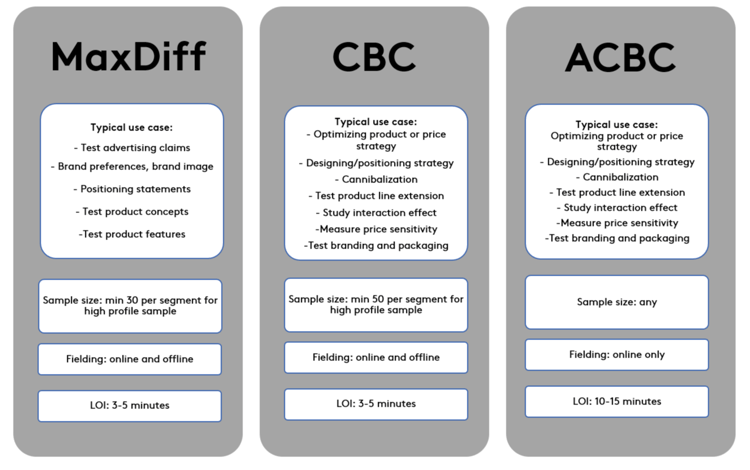Do you want to optimise your product development? Improve your market share? Achieve growth?
I mean, of course you do, who wouldn’t? But, at the same time, you’re finding this challenging. You can’t really pinpoint where the gap lies and identify what the next steps should be. Well, if that’s the case then keep reading. Because Conjoint Analysis might be the right solution for you.
Healthcare companies win over physicians by putting the right combination of features in their products and charging the right price. It is as simple as that; and Conjoint Analysis helps you do exactly that.

But, what exactly is Conjoint Analysis?
In essence, it is a marketing insight tool that helps you predict how the products you create will perform when taken to market. It employs a smarter, more scientific way to ask physicians and patients about different versions of the same drug or medical device in order to find the optimal one.
Through this prediction, Conjoint enables you to analyze the competitive landscape and position your company and your products accordingly. It gives you an insight into physician and patient preferences and allows you to evaluate the different features of your products based on their responses. In the long run, such a tool will give you the opportunity to asses and customize your offerings according to physicians’ and patients’ needs and wants. This will help grow your market share and push forward your revenue maximization strategy.
However, it is not a ‘one fits all’ solution. Rather, it’s a bespoke tool that offers a number of tailored approaches to fit your specific needs. The most typical conjoint used in the healthcare research sector are outlined below:
1. MaxDiff: Maximum Difference (Best/Worst Scaling)
One of the best options for looking at physicians’ and patients’ preferences and/or accessing the importance of different attributes of a product. MaxDiff demonstrates greater discrimination among items and between respondents compared to rating. It is usually used to test specific product concepts, different versions of the same product or even the market positioning of a specific item. On top of MaxDiff results, TURF (Total Reach Frequency) method could be applied for providing even further insight.
2. CBC: Choice Based Conjoint
The most traditional type of conjoint. It requires sufficient amount of sample, but can be lowered in the cases of professional audience. However, it is a great methodology for assessing and optimizing pricing strategy as it helps us delve a bit more into physicians’ and patients’ decision-making journeys.
3. ACBC: Adaptive Choice Based Conjoint
Unlike the first two types, ACBC is a more modern and refined type of conjoint. It is adaptive, meaning that it has an embedded real-time calculation that adapts to what the respondent is selecting on every question. This translates to a more dynamic approach that is great for testing different versions of the same product and assessing the importance of various aspects of a product for physicians and patients. In healthcare research, ACBC is often used in combination with MaxDiff.
There is no right or wrong choice when it comes to picking a type of conjoint for your project. What is important to understand is that different types are better suited for different projects. It all comes down to one thing: what are you trying to get out of this? Are you trying to find the perfect combination of product characteristics? Are you trying to devise a pricing strategy? Are you trying to identify a key gap in the market? Whatever your goal is, you can work closely and consult with conjoint experts to ensure you are on the right path to make it happen.
Typical Healthcare Example
Let’s assume you want to hear the opinion of 150 Oncologists in the UK, France and Germany (N=50 in each market) for a new drug you are developing. You are struggling to decide what attributes would be more appropriate for patients suffering from a specific type of cancer and you need them to answer a 15- minute survey to help you decide. Using the below guidelines, the right type of Conjoint for your case is ACBC.

All in all, Conjoint Analysis is a sophisticated choice analytics tools that can support an easier and more targeted decision-making process. Whatever it is that you’re trying to do, from designing your positioning strategy, to testing various product concepts or improving your market share, Conjoint Analysis can help you navigate the complex field of healthcare.





